Phira Phonruewiangphing/iStock Editorial via Getty Images
One of the most bizarre investor disconnects that I’ve seen in crypto is the one I’ve found in Litecoin (LTC-USD) over the last year or so. Like many other risk market assets, crypto investors can become emotionally attached to certain ideas. This emotional relationship that bulls have with their magic Internet monies is equally visible in the bears. We see this evidenced with some who will steadfastly ignore all blockchain-based assets as investable ideas. But this emotional bearishness against crypto isn’t just limited to the anti-crypto crowd. Even the crypto market has an illogical emotional problem with certain assets. One of those assets is Litecoin. Litecoin is a fork of Bitcoin (BTC-USD). It has 4 times the circulating supply, faster block times, and much cheaper transactions. While it has historically spent quite a bit of time as a Top 5 coin by market cap, it is currently placed at #20. Given the activity on the network, I think it should be higher.
Litecoin is a legitimate competitor to Bitcoin in the peer-to-peer payments category but so far the crypto investment community has been too saturated with BTC and ETH maximalists for LTC to get a proper bid. In this article, I’m going to show how little love there is for Litecoin in the crypto investment community as well as how Litecoin is proving itself to be a viable crypto with real payment utility. We’ll also explore valuation metrics that I believe will hammer home the contrarian opportunity we have in LTC.
Crypto Investors Hate Litecoin
The crypto investment market has virtually no interest in Litecoin. We can see this pretty clearly in the performance of Litecoin against Bitcoin. Through each crypto bull cycle, Litecoin has failed to make new highs when priced in Bitcoin. LTC now finds itself near all time lows when priced in BTC. One LTC measured in BTC has made lower highs and lower lows through each crypto cycle going from 0.04 BTC in 2013 to 0.0018 BTC earlier this year. The metric now finds itself at 0.0027 – still a far cry from the previous cycle high.
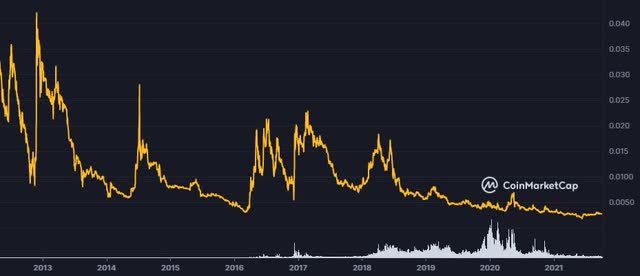
CoinMarketCap
We can see symptoms of this pricing underperformance throughout the crypto research community. Real Vision has a crypto portfolio survey where users share their views on a curated list of crypto coins. They have the option to vote overweight, underweight, neutral, or not to include the coin in the portfolio at all. Real Vision’s survey respondents have become more bearish LTC over the life of the survey. 20% of survey respondents voted to overweight LTC back in October 2021 with just 40% saying not to include LTC in the portfolio. The survey has now produced zero overweight votes in 17 of the last 20 weeks and three consecutive weeks with at least 70% voting not to include LTC at all:
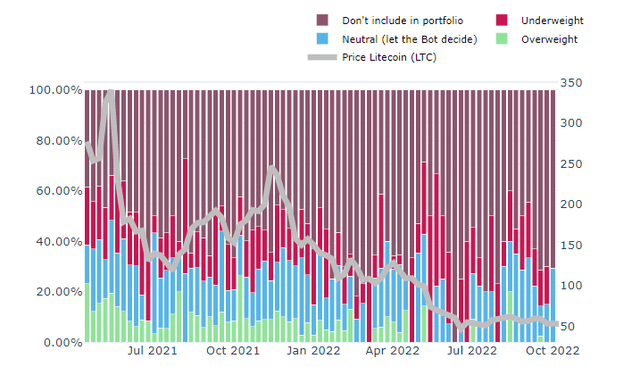
RealVisionBot.com
And it isn’t just Real Vision’s survey respondents who apparently don’t see the value in Litecoin. Crypto research firm Messari doesn’t appear to have published a Litecoin-focused analysis in almost 3 years. Even speculators have avoided Litecoin.
| Futures Open Interest | Oct 1 2021 | Oct 1 2022 | YOY |
|---|---|---|---|
| Bitcoin (000s) | 311.3 | 639.3 | 105.4% |
| Litecoin (millions) | 1.97 | 3.19 | 61.9% |
| Ripple (XRP-USD) (millions) | 741.45 | 1,567 | 111.3% |
| Dogecoin (DOGE-USD) (millions) | 1,657 | 2,419 | 46.0% |
| Bitcoin Cash (BCH-USD) (000s) | 384.8 | 1,470 | 282.0% |
Source: CoinGlass
While other crypto assets like Bitcoin have seen surging futures open interest over the last several weeks, Litecoin’s OI has lagged most of the other payments-focused blockchains. The one exception in that table is Dogecoin, which pulled forward much of its futures open interest speculation during the meme-stock/meme-coin mania over a year ago.
Litecoin is one of the cryptocurrencies one can get exposure to through the traditional open market via Grayscale’s Litecoin Investment Trust (OTCQX:LTCN). While almost all of the Grayscale funds trade at a discount to the Net Asset Value, Grayscale’s Litecoin Investment Trust has the third largest negative premium price arb among its entire portfolio of single-asset investment funds with a 41% discount to NAV:
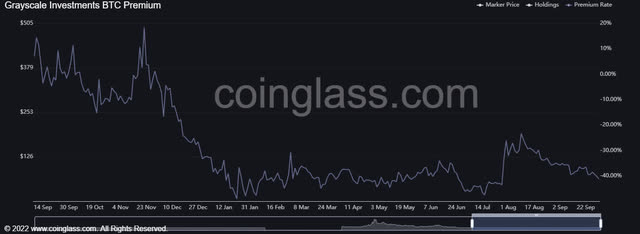
CoinGlass
When I covered Ethereum Classic back in late-August, I showed how there is a relationship between the magnitude of Grayscale’s holdings with the discount to NAV of the fund. Essentially, the argument I made was that the more Grayscale holds of a coin’s total market cap, the bigger the NAV discount generally is in the fund. Interestingly, the Litecoin fund was an outlier here:
| Grayscale Underlying Asset | Fund % of Total MC | Fund Premium |
|---|---|---|
| Ethereum Classic | 8.57% | -67.54% |
| Horizen (ZEN-USD) | 4.62% | -9.45% |
| Bitcoin | 3.26% | -36.19% |
| Ethereum (ETH-USD) | 2.41% | -30.86% |
| Livepeer (LPT-USD) | 2.35% | -54.13% |
| Zcash (ZEC-USD) | 2.10% | -22.33% |
| Litecoin | 2.08% | -41.25% |
| Bitcoin Cash | 1.60% | -25.69% |
| Decentraland (MANA-USD) | 0.97% | -1.18% |
| Basic Attention Token (BAT-USD) | 0.39% | -17.36% |
| Stellar (XLM-USD) | 0.30% | 6.38% |
| ChainLink (LINK-USD) | 0.06% | 27.76% |
| Filecoin (FIL-USD) | 0.04% | 426.32% |
Sources: CoinGlass, premiums as of 9/30 closes. Market Cap calculations from CoinMarketCap data and Grayscale holdings data
Despite Grayscale accounting for a larger percentage of the total market capitalization in six other coins, the Litecoin fund trades at the third largest discount; trailing only Livepeer and Ethereum Classic. Here again, we see the investment community’s disrespect for Litecoin.
Lack of Social Engagement
You’re also not going to find much Litecoin interest on Twitter. Over the last six months, there has generally been somewhere between 500 and 1,500 tweets about Litecoin on any given day.
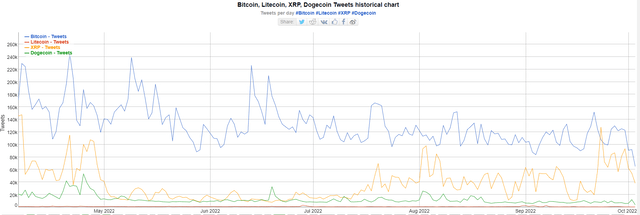
BitInfoCharts
This is far below the daily tweet activity seen in coin communities like Dogecoin, Ripple, and Bitcoin. If you can’t see the red line for Litecoin above, that’s because it barely exists compared to the other three coins in the chart. In a quick scan of Twitter for Litecoin-specific commentary, a lot of the engagement is negative and often results in one of Litecoin’s core critiques; Litecoin’s founder Charlie Lee pursuing a career at Coinbase several years ago.
Crypto Users Love Litecoin
Despite the lack of investment demand for LTC, Litecoin as a network continues to quietly impress in key network metrics like wallet addresses, hash rate, daily transactions. As evidenced by this mean hash rate chart below, Litecoin’s network security made a new all time high in September:

CoinMetrics
The more impressive metric I see in Litecoin though is the growth in LTC’s non-zero addresses compared with better capitalized payment peers. Below we can see that figure increased in line with the growth in Dogecoin and Ripple during 2021:
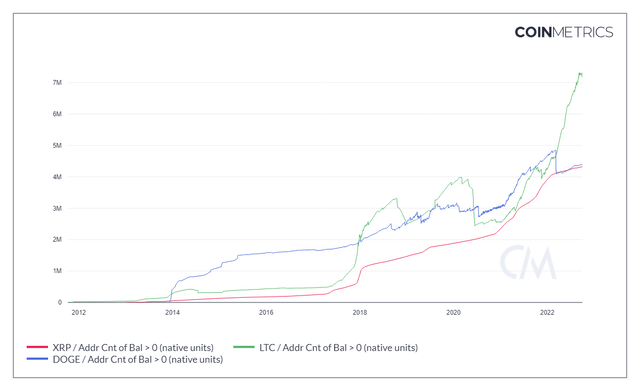
CoinMetrics
But 2022 has been all about Litecoin address growth compared to the two other networks. In addition to the growth in non-zero addresses over the last two years, Litecoin has arguably seen better decentralization than some of the other payment networks if coin ownership by top 100 addresses is any indication:
| Top 100 Addresses | Oct 1 2020 | Oct 1 2022 |
| Bitcoin | 14.2% | 15.7% |
| Litecoin | 41.7% | 32.6% |
| Bitcoin Cash | 29.3% | 34.7% |
| Dogecoin | 59.7% | 69.4% |
Source: BitInfoCharts
Bitcoin, Bitcoin Cash, and Dogecoin have all seen growth in Top 100 Address concentration while Litecoin has seen a large reduction from nearly 42% two years ago to a little under 33% now. Despite lower coin price highs when priced in BTC, LTC is still finding utility in transactions. LTC is now being used to a far larger degree than several other higher-ranked cryptocurrencies through Bitpay:
| % of Transactions | March | April | May | June | July |
|---|---|---|---|---|---|
| BTC | 56.8% | 56.5% | 54.9% | 53.3% | 47.9% |
| ETH | 11.1% | 10.9% | 10.5% | 9.7% | 10.0% |
| XRP | 0.7% | 0.8% | 1.1% | 0.7% | 0.6% |
| DOGE | 6.8% | 6.9% | 6.4% | 6.2% | 11.0% |
| LTC | 14.4% | 15.5% | 18.0% | 21.2% | 22.1% |
Source: Bitpay
While Litecoin has been the 2nd most utilized blockchain for transactions on Bitpay for several months, it is clearly taking share away from Bitcoin in a sustained multiple-month trend.
Valuation Metrics
When we look at the daily transaction count as a 30-day moving average, we can get a decent sense for how the networks are being utilized. Taking the 30 Day moving average for LTC and dividing it by BTC’s 30 Day moving average for transactions tells us Litecoin appears to be picking up momentum as a payment network.

CoinMetrics/BCR
As a percentage of Bitcoin’s daily transactions, Litecoin’s usage has grown from 5-10% during the years preceding the 2017 crypto bubble to over 40% now. One of the other ways one can look to value these crypto networks is with a metric credited to Bitcoin analyst Willy Woo. The metric is NVT Ratio or Network Value to Transactions. The way it’s calculated is by dividing the market capitalization by the daily USD-denominated transaction volume.
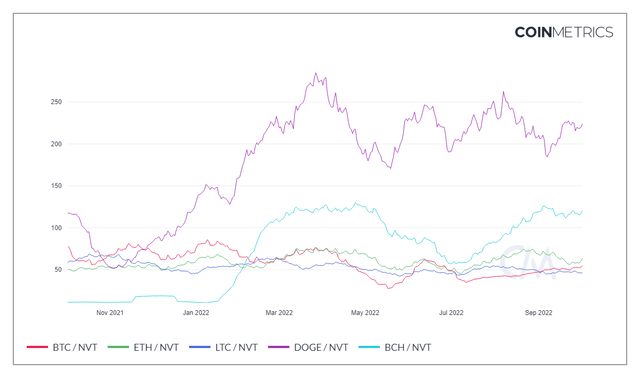
CoinMetrics
At a 46.2 NVT, not only has Litecoin been considerably cheaper than Dogecoin and Bitcoin Cash for years, but it’s cheaper than Bitcoin going back to September.
Risks
Like all cryptos, there is considerable risk when investing in Litecoin. Given Ethereum’s successful transition from proof-of-work to proof-of-stake, I think there will be added pressure on the remaining PoW chains to do the same. That could risk centralizing these public blockchains to a far greater degree should the chain developers buckle under the pressure and flip to PoS.
Summary
I firmly believe the crypto investment market is getting it completely wrong regarding Litecoin. LTC is one of the most utilized payment-focused blockchains for peer-to-peer transactions. Like Bitcoin, the hash rate for Litecoin continues to grow. The wallet addresses with non-zero balances have grown. And the concentration of top holders of LTC has actually declined over the last two years while notable payment peers have seen increases in concentration. Litecoin has become a valuable peer-to-peer payment network with good decentralization. Yet, the market still disrespects it for some reason. We can see that disrespect through the lack of coverage of the coin and through the egregious discount to NAV in Grayscale’s fund. The market hates Litecoin. But it shouldn’t.
Editor’s Note: This article was submitted as part of Seeking Alpha’s best contrarian investment competition which runs through October 10. With cash prizes and a chance to chat with the CEO, this competition – open to all contributors – is not one you want to miss. Click here to find out more and submit your article today!
